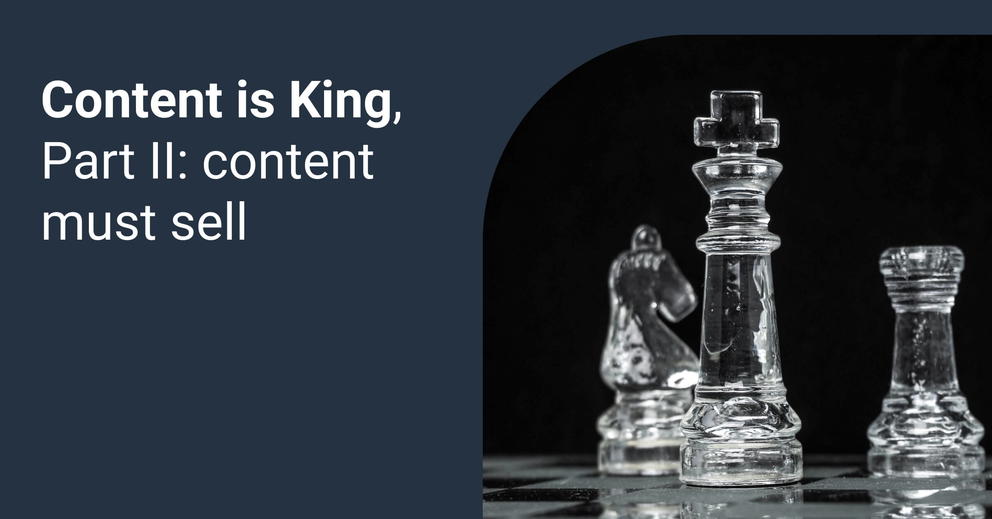Content is King, Part II: content must sell
Measuring performance is not compatible with creativity. Heard that a thousand times and it still sounds more of an excuse than an actual fact. The reality is that content must sell. And it must do so by engaging the audience and turning them into leads.

May 13 2021 ● 4 min read

In Part I of the Content is King article series, I covered the types of high-quality content. I like to categorise things where possible. It helps me write more structured pieces of content and keep a certain degree of control over my creativity.
I ended the article on a bit of a cliffhanger: what to do with the categorised types of content? The natural answer is to assign KPIs to each type. While I understand people who say that measuring performance is not compatible with creativity, the reality is that content must sell. And it must do so by engaging the audience and turning them into leads. It’s harsh, but it’s true.
Content as a lead magnet
In my opinion - and you are free to disagree - all high-quality content is a lead magnet. Every potential customer will come to your content platform, understanding that you use content to sell. It’s the content that has to be so good that the customer decides to buy the product/service because of the content you churn out. That is the ideal goal of all high-quality content.
Don’t worry. Stats are here to support my opinion. HubSpot’s survey suggests that the most common measure of content success are sales: 23% of marketers measure content success this way. The second most popular stat is web traffic, and the third - leads.
Ideal content goals
So, clearly, content is used primarily to sell. Given the deep relationship to sales, marketing agencies and departments everywhere need clear, numeric goals to showcase the success of their content. Just like with content categorization, here’s my take on the ideal goals all high-quality content should strive for:
Stand-alone content. Each type of content should have its own audience and survive despite the product or service it originates from.
What does this mean in numbers?
- Measure website traffic, a.k.a. audience size.
- Measure generated sales. Content must return the investment by bringing in more revenue than money spent.
- Measure content revenue. Stand-alone content has the potential to be monetised. Additional revenue sources for such high-quality content can mean a further expansion of the content net, more independence for the marketing team and even more sales for the company.
These are the three primary metrics that should determine if the content is booming. Depending on your target market, other candidates can be social media engagement, on-site engagement, or even the level of authority. This you might be able to measure using Google’s E-A-T scale.
Personalised marketing vs Personalised content
A few words about personalised everything that is sweeping the marketing world. Personalised marketing is everywhere now. The Function of Beauty calls itself the leading brand in personalised care, offering custom-filled shampoo bottles as a regular subscription. Beyond Body provides a personalised meal and fitness plan in the form of an actual printed book.
This is a part of a growing trend of personalised marketing that has no plans to stop. More than a third of all marketing specialists worldwide believe that more personalised customer experiences will establish a long-term relationship between the customer and the brand.
But notice something here: it’s the products and (potentially) services that are being personalised. Not the content the companies are using to promote them. This raised a question in my mind: how DO you personalise high-quality content? Is it necessary? No, but something else is.
The promotion of high-quality content should definitely be personalised. Email campaigns have been the most popular form of personalised marketing among 72% of US marketing specialists. Personalised messages for the audience, offering content that they would be interested in, is one way to go.
Social media platforms like LinkedIn (in B2B circles at least) offer opportunities to personalise content distribution via inMail messaging. I personally like this idea because you can really target only the people you KNOW your content will resonate with. In my case, it’s the marketing specialists that have the same nagging thoughts about what to write next and how to do it better.
Final thoughts
So, the type of king-level content can help you decide where to invest your resources. The (realistic!) goals set for the content will determine the size of distribution necessary to achieve those goals. And a touch of personalised flair will help better promote your high-level content to the relevant audience. Sounds like a recipe for success. I can’t guarantee the results, but I will indeed adhere to this action plan and see where it goes.
Published on May 13 2021

WRITTEN BY
Indrė Jankutė-CarmaciuIndrė is a copywriter at Whatagraph with extensive experience in search engine optimization and public relations. She holds a degree in International Relations, while her professional background includes different marketing and advertising niches. She manages to merge marketing strategy and public speaking while educating readers on how to automate their businesses.